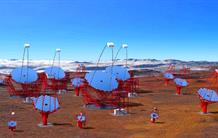The Cherenkov Telescope Array (CTA) consortium brings together 1300 scientists from 32 countries. They have published their scientific aims in a document over 200 pages long. This is the result of several years of work, and includes contributions from approximately fifteen Irfu researchers involved in X-ray and gamma-ray observatories (Fermi, Integral, XMM-Newton, H.E.S.S., etc.).
rom the ground, the Cherenkov telescopes detect the bluish light produced by the interaction of the atmosphere with very high energy gamma rays. In order to cover the entire celestial sky, the CTA collaboration is currently installing two telescope networks: one on the Armazones plateau in Chile, and the other on La Palma (Canary Islands). In total, approximately one hundred telescopes will make it possible to study the cataclysmic phenomena of the universe, with capabilities ten times greater than those of existing instruments. The first observations are expected by 2020.
Astrophysicists from the Irfu are primarily interested in the central region of our galaxy. This region contains mysterious ejections of matter (Fermi bubbles), discovered in 2010. Dark matter particles could also be accumulated there, emitting gamma rays while annihilating themselves. Finally, sources called "PeVatrons" could accelerate galactic cosmic radiation to the highest energies, up to 1015 eV (PeV or petaelectronvolt).
The researchers also want to study the gamma rays produced by stellar "duos" already observed in X-rays, where the surface of a star is "sucked in" by an ancient companion star that has become a compact celestial body (white dwarf, neutron star or black hole).
The CTA can also help to clarify various fundamental physics questions, such as testing Lorentz invariance or searching for new lightweight particles (axions), by studying the active nuclei of galaxies as well as extragalactic background light.
Finally, using an unprecedented sensitivity, the CTA will make it possible to search for the very high energy counterparts of gamma ray bursts and gravitational waves observed by other instruments.
Contacts: Thierry Stolarczyk (DAp), Emmanuel Moulin (DPhP)
• Structure and evolution of the Universe
• Department of Astrophysics (DAp) // UMR AIM • The Particle Physics Division




